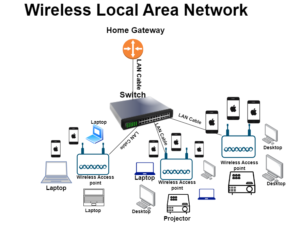A wireless Local Area Network (WLAN) is a local area network that uses radio waves to provide connectivity to end-host devices rather than the typical Ethernet cables used in a traditional LAN.
WLAN offers several advantages over a standard LAN because it allows users to maintain their network connection even as they travel a certain distance away from the access point without losing their connection.
In a wired Local Area Network, all host devices must be in a fixed location to retain their connection to the network, as the connection relies on cables with limited reach.
In this article, we will delve into Wireless Local Area Network Architecture, specifically focusing on how connectivity is distributed to host devices using WiFi technology.
Wireless Local Area Network Architecture
Wireless Local Area Network (WLAN) architecture comprises various Wireless Access Points interconnected using a switch, along with multiple host devices like personal computers, office phones, printers, and additional wireless access points.

The connection from your Internet Service Provider (ISP), whether through a fiber cable or twisted pair cable, constitutes the Wide Area Network (WAN) link and is directly connected to your home gateway. This gateway, also known as a router, converts the WAN link into a Local Area Network (LAN) link. This LAN link can then be extended from the router to the switch for further distribution.
The following are the components of a wireless local area network architecture:
- Customer Edge Router (Home Gateway): The home gateway serves as the initial component of a wireless LAN. It directly connects to the service provider’s network, obtaining a WAN link which it transforms into a LAN link. This gateway provides a port for connecting a switch to facilitate further distribution. It’s responsible for routing traffic from the LAN to the internet using the IP routing protocol.
- Switches: The switch receives the LAN link from the Home Gateway and distributes it to various wireless access points. In the network diagram above, a switch with up to 48 Ethernet ports (RJ45 ports) is shown. Three different access points utilize three of the 48 ports of the switch.
- Ethernet Cable (LAN Cable): The next network component is the Ethernet cable, usually a twisted cable with an RJ45 connector at each end. This allows the cable to connect to the switch’s Ethernet port and the host device’s RJ45 port. In the network topology depicted above, Ethernet cables are used to link the three wireless access point to three ports at the bottom row of the switch.
- Stations: Stations encompass all end devices that connect to the network wirelessly. The stations in the topology above includes laptops, smartphones, printers, terminals, and projectors.
- Basic Service Set: A Basic Service Set comprises all wireless devices that communicate with one another. It is the wireless access points joined with the host devices (stations) connected to them.
- Extended Service Set (ESS): An ESS is a collection of interconnected BSS (Basic Service Sets). It consists of various wireless access points joined together, each with different host devices connected to them. ESS configuration supports roaming. When user equipment moves from the coverage area of one access point to another, it automatically dissociates from the former and associates with the latter.
- Distribution System: The distribution system connects one access point to another, as depicted in the network diagram above. This system can be either wired or wireless.
How packet Move in a Wireless Local Area Network(WLAN)
Packet movement in a wireless local area network is not as complex as in a wide area network. When a host device wants to communicate with another host device, the packet does not need to traverse the internet or router; the packet will simply move from the host device through the switch and then to the destination host device.
The only time that packet movement gets complex in WLAN is when an end-user device initiates a request to a destination host that is outside the Local area network.
I am a passionate Networking Associate specializing in Telecommunications.
With a degree in Electronic engineering, I possess a strong understanding of electronic systems and the intricacies of telecommunications networks. I gained practical experience and valuable insights working for a prominent telecommunications company.
Additionally, I hold certifications in networking, which have solidified my expertise in network architecture, protocols, and optimization.
Through my writing skills, I aim to provide accurate and valuable knowledge in the networking field.
Connect with me on social media using the links below for more insights.
You can contact me using [email protected] or connect with me using any of the social media account linked below



